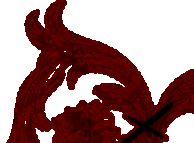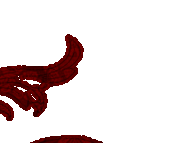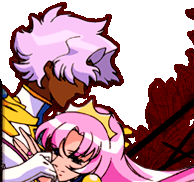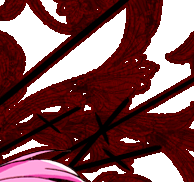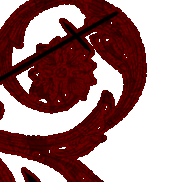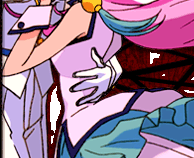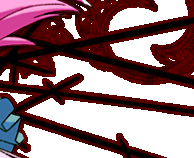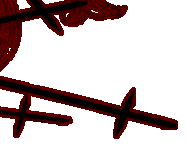
This analysis
was donated by Hugo Schmidt. 
This interpretation of the relationship between Jury and Ruka differs somewhat from the other one already up on this site. I believe that I have good reasons for my interpretation, and I urge the reader to read and compare. My first thesis is that Ruka is dying, and that by the end of the two episodes that he has died. My second thesis is that he is the closest to a true Prince that is seen in the series.
This last piece may sound a trifle strange. After all, Ruka goes out of his way to act as the foulest bastard in the school, and does absolutely everything in his power to make Jury loathe him. He seduces Shiori knowing full well the effect that it will have on Jury, kisses Shiori while Jury watches and then humiliates Shiori in the most painful manner possible. Then he forces himself on Jury and almost smashes her locket. This is far beyond the casual cruelty that Touga or Saionji exhibit which is merely a side effect of their short-sighted egotism. This is planned and calculated sadism. The reason that moves him to do this is the most counterintuitive one imaginable: Ruka genuinely, purely, and deeply loves Jury. It is unclear whether this love has a romantic aspect or not. It could be that he simply admires and worships her as a being of unique potential, or it could be that he once had romantic inclinations towards her but set them aside for obvious reasons. Either way, it does not change the effect of his actions. Jury is the single most important person in Ruka’s life. She means so much to him that nothing else can matter to him but her welfare, not even her feelings for him. As Ruka says, Jury’s potential by far outshines any others, including his own. Jury is – as another essay here argues and as the film clearly states – a Prince in her own right. Jury responds that she eventually hit a wall, i.e. that there are internal blocks that prevent her from becoming everything that she could – and should – be. There are two blocks. The first is, obviously, Shiori. The second is, ironically, Ruka himself. To explain, when he returns from Hospital when he comments on her lack of progress, she answers that he is still the captain of the fencing team, that she has only ever been acting captain. This is indicative of a deeper block; she does not need to push her further. There are other hints, especially in the scene where Jury confronts Ruka in the room with three chairs. Her words are: “What a bastard you’ve become” [emphasis added]. Inference: that Ruka was not always such a bastard. Also, when he forces himself on her she hesitates for the briefest of moments before throwing him away. From Jury, even such a small hesitation speaks volumes. Finally, in the Akio car, Ruka says something incongruous: “’Believe in miracles and they will know your feelings.’ Weren’t those your words?”. Jury’s, not Shiori’s. It is easy to imagine that Jury repeated them to Ruka to give him some measure of hope when he went into hospital. This, in combination with the fact that Jury obviously was his favoured pupil, indicates that, at some level, Ruka is an excuse for her not reaching her true potential. After all she’s only minding the club in his absence. Ruka realises this, and realises that there is only one way for him to make her overcome this block: She needs to hate him, needs to be made to loathe him, to the point where his very existence revolts her. This will remove the block, and close off that excuse, Jury will not submit to having a total bastard be set higher than her. And this has to be done before he dies, else his shadow will always haunt her and she will never be free of him.
His method for doing this brings into play Jury’s other block: Shiori. Now, if there is a single character in the whole of the series that is utterly contemptible, if there is one character who is the best example of pure evil it is Shiori. This may sound a trifle extreme with characters like Akio and Touga wandering around the place. Yet consider the following: At least Akio and Touga hurt others in the process of reaching some goal of their own. They possess some desire to reach something more, some purpose of their own. Consider Shiori. We learn everything that we need to learn about her in episode seventeen, the Black Rose episode “Thorns of Death”. In contrast to any other of the characters in Utena, Shiori has no purpose of her own. She simply hates Jury. She hates Jury, not for any wrong that Jury has done, but for quite the opposite reason. She hates Jury for Jury’s ability, for her nobility, her love, her devotion, her virtue, her kindness, for protecting Shiori when they were younger. In short she hates Jury for being good. She does not want to exceed Jury, she wants Jury to be dragged down, she does not want to gain, she wants Jury to lose, she does not want happiness or love or any human value, she want Jury to be deprived of these things. There is no more foul a motivation in the world.
However, even when she realises how much she hurts Jury, she can take no true pleasure in it, as her final reaction in the elevator shows. Why is this? Because even when Jury is in pain, when she is suffering the worst of her torments she is still infinitely beyond Shiori. Even Jury’s suffering is a noble emotion, one too exalted for Shiori to ever experience. Shiori will never feel true devotion or love in her entire life – and she knows it. Ruka realises all of this, and it is probably what galls him most of all. To think that his master student, that someone as great as Jury should suffer and be held back by a creature like Shiori must be the worst torture imaginable. While he wouldn't act as he does if it didn’t, ultimately, help Jury be free, I suspect that he takes a certain delight in doing what every red-blooded Jury Arisugawa admirer out there has been itching to do: Rip Shiori’s heart clean out of her chest and stamp on it. It is partly Justice: let Shiori feel the some of the pain she causes Jury. But it also serves a purpose, by illustrating to Jury just how corrupt Shiori is. When Ruka asks Shiori what it is that she wants him to believe she says: “That I love you more than… that I love you more than anyone else.” Note the hesitation. Anyone care to guess the name that she omitted? And whose sword she was really polishing? Based on this, it is also probable that Ruka sleeps with Shiori earlier on; using sex to express contempt and domination have strong antecedents in the real world, not to mention in Ohtori. As Ruka continues to drive Jury into a corner, he is also telling her what he is doing, but in a veiled manner. As he explains: “You only get miracles by standing on the sacrifices of others”. Jury curses him and calls him a coward for using Shiori as a sacrifice. In fact, he probably means his own sacrifice. He is burning everything, his life, Jury’s feelings for him, his dignity, as fuel for Jury’s “miracle”: her freedom to reach her true potential and find happiness. Jury tells him that she would only use the power of miracles to free her from him. With a minor alteration, he could say exactly the same thing. He keeps his back resolutely turned to her throughout the discussion – this is a common tactic when someone is afraid that their face will betray their true feelings. Ruka also shows Jury where her own shortcomings lie. Consider the duel between the two of them: Jury commits mistakes that are strikingly similar to Utena’s in the Rose Saga, while Ruka deflects her blows with ease, just as Jury does originally. The Akio car scene and its precursor suggest something intriguing. That Touga plays a set part and does not interfere probably means that Akio and Touga are playing it as straight as possible with Ruka. They need Jury to duel so that Utena can reach the duel called “Revolution”, but Jury isn’t one easily manipulated. Only Ruka could have caused her to fight, but he isn’t one to be easily manipulated either. The only bribe that could have worked is the chance to set Jury free. It is easy to imagine that Akio or Touga set the proposition out in clear, simple terms and that Ruka agreed. Having driven Jury half mad with anger, he fuses all the dispersed elements in the ultimate crucible – the Duelling Arena.
 "I Am All the Mysteries in Creation" Interpreted At this point it is worth examining the lyrics of the duelling song. Note that I by no means consider my analysis exhaustive, so I am concentrating on those portions that I consider the most important:
An ode to the face, an ode to the head
An ode to the hair, an ode to the nails
An ode to the chest, an ode to both arms
An ode to both legs, an ode to the body
An ode is a lyrical poem, originally sung by Greek choral performers. Odes typically celebrate or revere something, as in Beethoven’s Ninth symphony the Ode to Joy. This is a celebration of the body, but not in the carnal sense. An ode is something considerably more solemn. This is closer to the celebration of a well-formed vessel to carry the human spirit – the body as a temple. This is emphasised by the next two lines.
Their names are crests,
The heraldry of the human body
Crests and heraldry are symbols of nobility. In literature there is a strong tradition of physical types representing the spirit they contain. Jury is an excellent example of this; her form emphasises strong, clear lines, even in her hair that appears more like sheet metal than normal curls. Her reserve and the inner strength that reserve is a sign of can be seen on her.
The form I see in the mirror
Complex and subtle manners and mores
Black and White court etiquette
Jury has a healthy distaste for displays of emotion and rarely allows it to impinge on her life. Witness the way that she runs the fencing club with superlative efficiency. Witness how, even when Shiori is twisting the knife in “Thorns of Death” Jury stands her ground. It is very, very rare that she allows herself to lose control. Hence manners and mores – these emphasise clear guidelines of what may and may not be done. Courtly etiquette is the most formal and hence most rigid manifestation of these. There is nothing arbitrary about them, nothing subject to the whims of the moment. Jury lives her life by having clear rules and adhering to them, regardless of how she feels at a given moment.
White and black in an ever-opposing pattern
Underneath the reserve and control, Jury is subject to a maelstrom of painful and debilitating emotions. This is the opposition in question.
People drawing complicated symbols
The art of history via baroque techniques
Again, the emphasis is on heavy formalism, complex but clear rules. In addition, this may well be a reference to Ruka’s actions. They have been heavy-handed, extreme, over the top – in short, Baroque. Of course, this is due to the nature of his situation – he has only one chance to get it right. He cannot afford to experiment with half-measures. Baroque also has strong connections with religious devotion, with the complicated sacraments of Catholicism. One of its themes is ever increasing magnificence – a fine metaphor for the continual increase of Ruka’s manipulation.
Salamanders, Dragons, Wild Boars These are heraldic animals, once again underlining Jury’s innate nobility. Also, the animals in question contain very appropriate imagery. Wild Boars are traditionally the animals of Artemis, the virgin huntress and goddess of the moon. It is a warrior’s symbol. The Dragon symbolises the most valiant of all living creatures, that guard’s precious treasure. The word “Dragon” is from the Greek, meaning “to see clearly” – Ruka is trying to open Jury’s eyes – and to a certain extent he does so at the end. It is also a symbol of transformation, a theme that is emphasised further on in the lyrics. Ruka is putting Jury through the crucible of transformation, and it isn’t a pleasant experience. Dragons can be both symbols of evil and chaos, as well as symbols of good and perfection. Here again is the “White and black in an ever opposing pattern”, the marriage of opposites. Ruka appears evil, yet is working good. The Salamander lives in Fire and is yet another symbol of transformation. More importantly, it was adopted as a personal symbol by Francois the First, the Holy Roman Emperor whose personal motto may be translated as “I nourish the good and extinguish the bad.” Is this not what Ruka is trying to do?
Holy objects, sacraments, faith, virtue
Yet again, the symbolism of the Sacred comes up. The sacred is that which should not be touched by the profane. How does Ruka see Jury?
The sealed away miracle of the Rose
The bloom of man and beast
Things sealed away are too precious for common touch. ‘The Bloom’ is the completition of a flower’s development, when it truly comes into its own. The “man and beast” is a reference to the struggle that Jury goes through, her intellectual qualities and nobility (man) fighting the pain of unrequited love and of unreasonable emotions (beast). The ‘miracle’ is, of course, a central theme to all of this.
Pearls and gems
People and age
A crucifix of diamond flowers
The last portion of these lines is the most relevant. Crucifixion represents enduring a pain for the sake of the sacred, a holy burden. “Diamond flowers” could refer to Jury’s present state of arrested development, but it more likely represents the ultimate state that Ruka wants for her. Diamond flowers will never fade or whither, but remain always immaculate. Diamonds are also the final stage of transmutation, turning base coal into a precious material. I am reminded of a parable from Nietzsche’s Also Sprach Zarathustra wherein he states that what differentiates diamonds from coal is their hardness, their resilience, their endurance. Again, this is all indicative of Jury. She would never break down in public in the utterly shameless manner that Shiori does. The Nietzschean theme of self-overcoming is central to all of Utena, but these episodes show it more clearly than others.
Gold, Silver, Purple, Green, Red, Blue, Black
In heraldry, these colours have the following names: “Or, Argent, Purpure, Vert, Gules, Azure, Sable”. These are technically referred to as tinctures, a name that also refers to an alcoholic extract of a substance. Jury as the distillation of nobility, perhaps? To further emphasise nobility, the next names are all of important palaces, castles, grottos, churches and similar. Furthermore, such buildings can refer to the tremendous character that both Jury and Ruka have built for themselves, of the inner purity and strength that they embody. Certain mystical sects refer to the well-cultivated spirit as “the temple not built with hands”. The theme of improving your own spirit and character by hard work and effort is one that has occurred in many great moral traditions, from Aristotle’s Nichomachean Ethics, through Marcus Aurealius, down to Nietzsche and his contemporaries. The theme is one of being concerned more with ones own perfection – and rightly so – than with the external world; hence this is not an “altruistic” quest. In the manga for the Utena film, Jury comments on how she has struggled long and hard to rid her soul of filth. While there are many differences between series and film, not to mention between the series and the film-manga, Jury’s essential character remains fairly well preserved.
Alhambra
A palace in Granada, Spain. Its name has been said to mean either “the red” or “The House of the Master”.
Isubahan A mistranslation of Ispahan, a beautiful city in Iran, designated by UNESCO as a world heritage site. Its architecture is known for uniting the various beautiful portions into a seamless whole.
Caserta A palace near Naples, the largest erected in Europe in the eighteenth century. It is built in the imitation of Versailles and is considered the best of such imitations. Linderhof One of the three castles built by King Ludwig II of Bavaria, also known as “Mad King Ludwig”, and the only one ever completed. It is worth mentioning here that in Bavaria especially, Ludwig is still seen as something of an idealised, fairytale king – a Prince, in other words.
Cheval A reference, probably, to Ferdinand Cheval, a postman who spent thirty-three years of his life building an ideal palace. Here is the theme of building, and construction. [N.B.: In this instance I am, for once, including a portion given by Ohtori.nu that does not appear in the official, DVD translation. This is because it appears highly appropriate.]
Schwarz
This is a name that is hard to analyse, because it is a very common one. I consider it to be a reference to Berthold Schwarz, the German monk with an interest in alchemy who was the first European to discover gunpowder (in German Schwarzpulver, lit.: Schwarz’s powder). This seems to fit the general theme of transformation well, along with the religious imagery that keeps coming up.
Bomarzo An Italian town that contains the Bosco Sacro (Sacred grove) or Bosco de Monstri (Monsters’ grove). Containing a small, temple-like chapel, this garden is known for its strange, phantasmagorial statues of monsters and beasts. The symbolism is perfectly clear – the struggle against inner demons to preserve the sacred, and the pure.
Flora Flora is the roman goddess of flowers, which ties in well with the various floral terms that have been mentioned already. It was in the Renaissance that Flora truly came into her own, particularly with Boticelli’s painting Primavera (Italian: Spring). The painting shows the god Zephyrus (the Wind God) transforming the nymph Chloris into the goddess Flora. Again the theme of transformation, with Ruka as the transformer.
Mathias Mathias is the apostle selected by drawing lots to replace the vacant place left by Judas Iscariot. The main reason for his inclusion is probably the line attributed to him by Clement of Alexandria: “"we must combat our flesh, set no value upon it, and concede to it nothing that can flatter it, but rather increase the growth of our soul by faith and knowledge”. The combating of the self, the reforming of the person, and the improvement of the soul – again, Jury’s conflict with her inner demons.
Versailles The great French palace. Comment is superfluous.
Obelisk The great standing stones that were decorated with the names of nobility in ancient Egypt, Rome, Assyria et al. Again, comment seems superfluous.
Sahmekh The fifteenth letter of the Hebrew alphabet. It is said to represent a coiled serpent, which is reminiscent of the serpent Ouroboros – another symbol of transformation and metamorphosis. In the Thoth Tarot deck, Samekh is associated with the fourteenth of the Major Arcana – Art. The card depicts the alchemical union of opposites, the combination of light and dark in a crucible. One of the names associated with this card is “mutable fire”. Finally, and most interestingly, in the Caballa, the path of Samekh leads from Yesod – the foundation – to Tiphareth, beauty and perfection. It is a path that rises straight upwards, the quickest and fastest root to the crown. Also, its colour is blue. This is emblematic of Ruka and how he is guiding Jury to her true perfection.
Isola Bella Italian for “Beautiful Island”. A small island known for its beauty. An ocean-bound Linderhof, in its own way.
Anfi Teatro A corruption of Amphitheatre – the great amphitheatre in Rome that used to hold gladiatorial contests. A reference to the duelling arena that they find themselves in and further to the continual conflict that the episodes have been about.
The Grotto of Orpheus
Orpheus famously descended into the underworld to rescue his love, just as Ruka tries to rescue Jury from the world of her pain. Also, in Salzburg – another beautiful city known fort is architecture – there are the Hellbrunn gardens that contain an Orpheus grotto. The palace there is known as the Mirabelischloss, a combination of German and Latin meaning “miracle-palace”. Jury’s own castle of eternity.
Neuschwanstein Neuschwanstein is the fairy-tale palace, to the extent that the Disney logo is a stylised variant on it. Another one of King Ludwig's works. This is the final, highest embodiment of the honourable, noble spirit that Jury represents.
Santa Maria della Concezione
A final, grim ending. This cathedral is famous for its crypts containing furniture and architecture made from the bones of those monks there interred. In the end Jury’s miracle – the cathedral of her spirit – must rest on Ruka’s bones, on the sacrifice of his very life.
Caves, sculptures, fountains, parks, palaces
Bronze-work, frescos, domes, castles, villas
Everywhere around, the forms of my life
Jury’s life is one of rigid self-discipline. There is little “organic” about her, little that is a product of chance or whim. Everything is created by purpose – with the exception, of course, of her attachment to Shiori.
Near and far, I am 100 wonders
All creation, I am 100 wonders
All the world, I am 100 wonders One final reference to the “Wonders of the world”. More deeply, only Jury can give herself the miracle that she wants. She is her own motive force, the only wonder that she can ever have. As the song reaches its climax, Utena’s blade comes down – and does not hit the rose, but the chain that has been holding Jury in bondage, her locket with the picture of Shiori. How does one interpret this most climatic scene? Jury stumbles around in pain, having lost the reason that brought her to the arena. She sees Shiori, and the orange rose that Shiori gave Jury – the same rose that Jury now tears off her chest. Finally, Jury is free. The thing within her that has been killing her has been torn out at the root. She is in pain, yes, and the rain falls in place of her tears, but the wound she has now is one that will finally heal. She is finally rid of the dreadful hold that Shiori has had of her. This is what Ruka means when he tells her that everything will be all right. Ruka’s purpose is accomplished and now, at last, he can die in peace. In Also Sprach Zarathustra Nietzsche argues that death itself can be a victory if even your death serves your purpose. He writes that those who have “goals and heirs can die at peace”. Jury is Ruka’s heir in spirit, which is symbolised by her now being Captain of the Fencing Team proper as opposed to acting. As Jury leaves the hospital, the predominant colour of the world around her is orange – as opposed to those scenes cast in blue, where Ruka dominates. This is now Jury’s world, and she walks past Shiori without noticing. Perhaps Shiori has finally realised the level of her own corruption, and what she rejected from Jury – but it is too late now. Shiori cannot even approach her, but walks, unnoticed, several paces behind. Ruka the Prince achieves the happy ending that he has fought for; what happens now is in Jury’s hands alone.
 Postscript This particular essay draws on a number of sources, unlisted because I cannot remember half of them. In the main, my research was done with the help of Wikipedia. Some might object to the “happy ending interpretation” given the final scenes of Utena, where Shiori steps up to fence with Jury. However, there are any number of explanations for this – Jury might be so far healed that she does not even feel resentment towards Shiori anymore, she simply feels nothing. Or it could be Akio “resetting” the duelling game to try again. I stand by the interpretation given above.
 |

